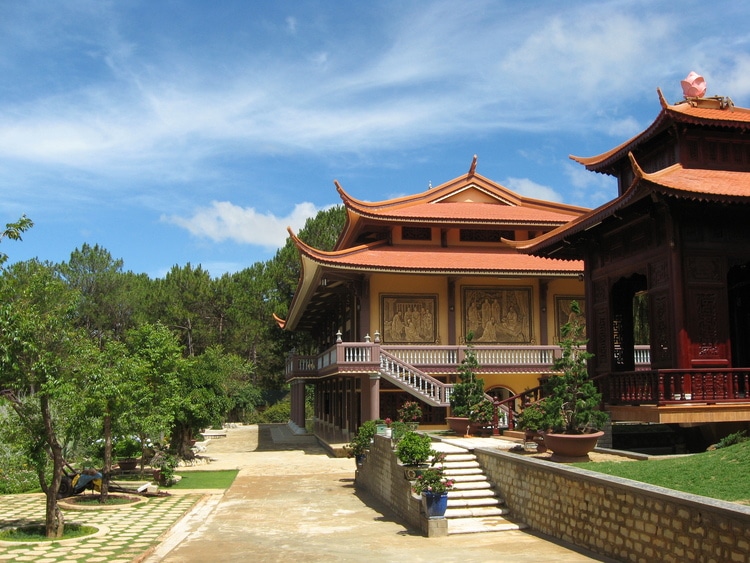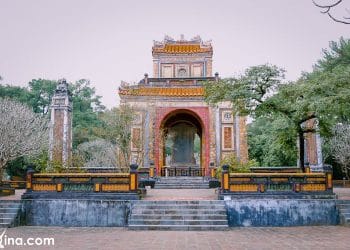Contents
Landing on Truc Lam Bach Ma monastery in Hue, its fantastic artworks of religious architecture will allure you in ancient patterns and curved roofs. People seem to immerse themselves into the calm and fresh atmosphere and relieve their mind in hearing the sound of the bell vibrating around.
Truc Lam Bach Ma monastery, one of the tourist attractions in Hue, is famed for its ancient beauty with tranquil and graceful patterns. This place wafts the scent of agarwood incense and the vibrating sound of the bell, tourists feel peaceful in mind as getting rid of sorrow.
Read more: Chau Son Sacramento Monastery: A Mystery Attraction In Ninh Binh / Truc Lam Phuong Nam Monastery In Can Tho City
Location
Truc Lam Bach Ma monastery lies in the middle of Truoi pond in Loc Hoa commune, Phu Loc district, Thua Thien Hue. Not only does the monastery belong to Truc Lam Yen Tu Zen in central Vietnam; but it is also considered the beautiful landscape in Hue. Along Truoi dam, it is about 500m to see Truc Lam Bach Ma in the middle of Truoi pond; then you have to go by ferry to arrive at this place.
History Of Bach Ma Mountain:
Thuong Thanh Ha Tu was the founder of Truc Lam Bach Ma Monastery in Hue. In 1932, French construction engineer discovered Truoi Mountain and Bach Ma region. Until 1945, people built Bach Ma city with 139 luxurious villas in French architectural style with enough places such as market, hospital and post office.
In war, the city was thought to be neglected, and everything remains in Hue people’s memory. However, Bach Ma is now restored especially Truc Lam Bach Ma Monastery, which is regarded as the strength of the land. The reason why people call it Bach Ma because viewing from Luong Dien Bridge (Truoi) or Ngu Binh Mount (Hue), you will see white clouds atop the mountain as the horse shape. In the western’s idea, Bach Ma means the sun with warm sunlight. When looking from the monastery, you can contemplate the magnificent natural landscape, tremendous mountains covered by lines of green trees, white clouds floating in the middle of the hill.
Architecture Of The Monastery:

Truc Lam Bach Ma monastery is divided into three areas: the front of the monastery – main hall to worship Gautama Buddha meditating in the root of the Bodhi tree, behind the main hall is the place to worship Bodhidharma of Truc Lam Zen. Abbey is the religious place for male monks and male Buddhists, while nunnery is for female monks and female Buddhists.
To get to the three-gate entrance of Truc Lam Bach Ma monastery, tourists, monks and Buddhists have to take 172 stone steps. The bell tower was designed in traditional temple-pagoda style with two floors, eight curved roofs which were tiled with slate tiles and sculptured flowers, dragon’s head. The pagoda gate and monastery (to worship Buddhists) are three gate entrances and different from the architecture of the temple gate in two-J shape straight to the sky.
The three gate entrance in the monastery includes one main gate and two extra doors. Each path has its origin and meaning, for example, the right extra gate is for civil mandarins, and the left extra gate is for military mandarins. And the middle entrance is for kings, monarchies or statesman. There is a wide belief among people that if one wishes to become civil or military mandarins, they should go into the extra gate 1 or 2. Notably, no one enters the middle gate because it means you are rude and do not pay respect to deceased emperors.
Beautiful Landscape:
The flat slope in the middle of the hill, the monastery gradually appears like a lively natural picture with rising and falling mountains, rocks were interspersed with vegetation and leaves with blooms. The sound of stream vibrates like echoes from the orchestra of nature and birds. In the alluring landscape, people look like tiny creatures among the magnificent nature and immerse themselves in poetic scenery. The three gate entrance appears high and solemn in the blue sky. You can roam up to visit the view and the religious architecture inside the monastery. They are all covered by the mountain, green forest, and seemingly the flower garden with meticulous care beautifies the campus. Here, people get lost in the tranquil, light-hearted place with peace of mind.
Also, in the region of temperate climate coupled with the location near Bien Dong (Eastern sea), about 5km and at the ideal height (1450m), Bach Ma is such a suitable place for travelling. The hill of Truc Lam Bach Ma monastery lies on the Truoi pond’s centre as a pure lotus, sitting next to magnificent Bach Ma Mountain. Perhaps, a mystical Bach Ma associated with Truc Lam meditation stream creates the charming beauty with full of vitality.
Daily Activities In Truc Lam Bach Ma:

Setting foot on the monastery, everyone can have a chance to experience staying in mediation that means “tu tam tai tam tat yen tam”(have self-improvement, have peace of mind). The monastery is always willing to help people, so when you come here, you will be carefully instructed. Reaching the mediation is the time when your mind is the most released, people live in the present life but set their mind at rest. When coming to the monastery to meditate, people will be instructed by monks. You have to follow daily routines here and obey a particular time table, for example, wake up at 3:00 am and mediate in two hours, 6: am is breakfast time, then participate in working. Lunchtime and resting in one hour, then learn Buddhism theory and recite the Buddhist in the afternoon. In the evening, you have to meditate in 1.5 hours until bedtime at 10:00 pm and repeat in the next day. If you do not get the eagerness to meditate, you can learn about national Buddhism with pictures and information sculptured in the monastery’s walls.
Truc Lam Bach Ma monastery is such an ideal place to take an escape the present life in noisy cities because you will immerse yourselves into the peaceful and spacious atmosphere not only in the monastery but also in tremendous Bach Ma Mountain. Tourists should not ignore a wonderful place like this one if you are in search of a tranquil location.
By Anh Tu















